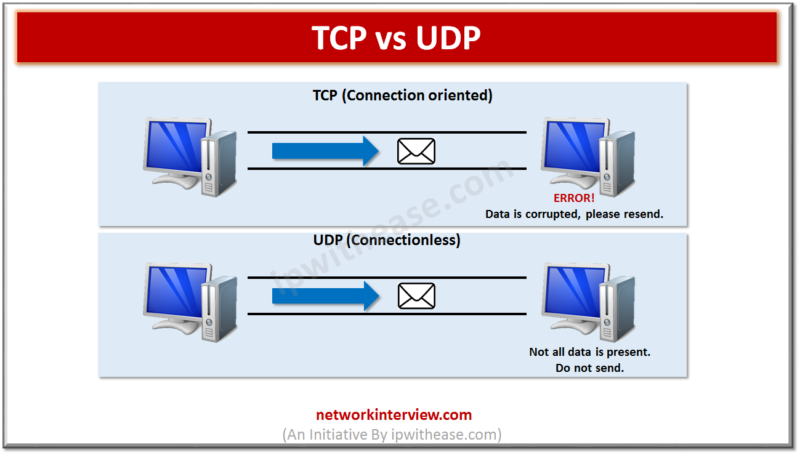
TCP vs UDP
TCP (Transmission Control Protocol) and UDP (User Datagram Protocol) are two core protocols of the Internet Protocol (IP) suite. They differ significantly in their features, use cases, and reliability.
TCP vs UDP
Here’s a detailed comparison:
1. Connection Handling
- TCP: Connection-oriented. Establishes a connection (3-way handshake: SYN, SYN-ACK, ACK) before data transfer and terminates it (FIN/ACK) afterward.
- UDP: Connectionless. No handshake; data is sent immediately without setup.
2. Reliability
- TCP: Reliable. Guarantees delivery using acknowledgments (ACKs), retransmissions, and error checking.
- UDP: Unreliable. No ACKs, retransmissions, or guarantees of delivery.
3. Ordering
- TCP: Ensures in-order delivery using sequence numbers.
- UDP: No ordering; packets may arrive out of order.
4. Speed & Efficiency
- TCP: Slower due to connection setup, acknowledgments, and retransmissions.
- UDP: Faster and lighter, with minimal overhead.
5. Flow & Congestion Control
- TCP: Adjusts transmission rate dynamically to avoid network congestion.
- UDP: No congestion control; can flood the network.
6. Header Size
- TCP: Larger header (20-60 bytes) with fields for sequencing, ACKs, and control flags.
- UDP: Smaller header (8 bytes) with only source/destination ports, length, and checksum.
7. Use Cases
- TCP:
- Web browsing (HTTP/HTTPS)
- Email (SMTP, IMAP)
- File transfer (FTP)
- Secure shell (SSH)
- Database communication
- Any application needing reliability.
- UDP:
- Video streaming (e.g., YouTube, Netflix)
- VoIP (e.g., Skype, Zoom)
- Online gaming (e.g., Fortnite, Call of Duty)
- DNS queries
- Live broadcasts (e.g., Twitch)
- IoT sensors (where speed > reliability).
8. Error Checking
- TCP: Full error detection and correction via checksums and retransmissions.
- UDP: Basic checksum for error detection (no correction).
9. Multicast/Broadcast Support
- TCP: Only unicast (one-to-one).
- UDP: Supports unicast, multicast (one-to-many), and broadcast (one-to-all).
10. Examples in Networking
- TCP:
HTTP (Port 80)
HTTPS (Port 443)
FTP (Port 21)
SSH (Port 22
- UDP:
DNS (Port 53)
DHCP (Ports 67, 68)
QUIC (Used in HTTP/3)
SNMP (Port 161)
Difference between TCP and UDP
Below table summarizes the difference between UDP and TCP:
| Feature | TCP | UDP |
| Connection | Connection-oriented | Connectionless |
| Reliability | Reliable (ACKs, retransmits) | Unreliable (no guarantees) |
| Ordering | In-order delivery | No ordering |
| Speed | Slower (overhead) | Faster (minimal overhead) |
| Flow Control | Yes (adjusts rate) | No |
| Header Size | 20-60 bytes | 8 bytes |
| Use Cases | Web, Email, File Transfer | Streaming, Gaming, VoIP |
When to Use Which?
- Use TCP when data integrity and reliability are critical (e.g., file downloads, emails).
- Use UDP when speed and low latency matter more than reliability (e.g., live video, gaming).
Tag:comparison, protocol



